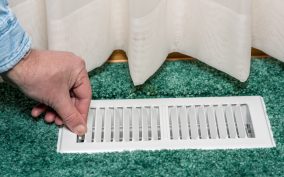Jul 3 2024
How to Extend Your AC Unit’s Life With a Ceiling Fan
Maintaining your air conditioning (AC) unit is crucial for helping it operate more efficiently and last as long as possible. One often overlooked method of extending your AC unit’s lifespan is the strategic use of ceiling fans. Understanding how ceiling fans work and using them properly can reduce the strain on your AC unit and prolong its life, saving you time and money in the long run.
Understanding How Ceiling Fans Work
Ceiling fans create a wind-chill effect that cools the body through evaporation. As the fan blades rotate, they create a downward flow of air that creates a breeze, making you feel cooler. This sensation is similar to the feeling of wind on your skin when standing outside on a windy day. However, unlike AC units, ceiling fans do not actually lower the temperature in a room.
How a Ceiling Fan Benefits Your AC Unit
Ceiling fans help distribute cool air more evenly throughout a room, reducing the workload on your AC unit. When the AC doesn’t have to work as hard to maintain a consistent temperature, its components experience less wear and tear. This reduction in strain can significantly extend the life of your AC system. Additionally, using a ceiling fan allows you to increase the temperature on your thermostat without sacrificing comfort. The U.S Department of Energy estimates that using a ceiling fan allows you to turn up your home’s temperature by 4 degrees – think about the cost savings!
Best Practices for Positioning and Using a Ceiling Fan
Optimal Positioning
To be most effective, ceiling fans should be installed in rooms with ceilings at least eight feet high. The blades should be positioned seven to nine feet above the floor and about a foot from the ceiling. Ensure that the blades are at least eight inches from the ceiling and 18 inches away from the surrounding walls to allow optimal airflow.
Selecting the Right Size
Choosing the right size ceiling fan for your room is crucial. For rooms up to 225 square feet, a fan with a diameter between 36 and 44 inches is adequate. Larger rooms may require a fan of 52 inches or more in diameter. In spaces longer than 18 feet, consider using multiple fans to ensure even air distribution.
Direction and Speed Settings
During the summer, make sure your fan is rotating counterclockwise to create a cooling downdraft. This setting enhances the wind-chill effect, making you feel cooler. In the winter, reverse the direction to clockwise at a low speed to circulate warm air trapped near the ceiling, which can help reduce heating costs.
AC Maintenance: The Best Medicine
While integrating ceiling fans into your home’s cooling strategy is an effective way to extend the lifespan of your AC unit by alleviating its workload, it is imperative to recognize that the most reliable method for ensuring the optimal condition of your AC unit is through a steadfast commitment to regular maintenance and timely repairs. Engaging a professional HVAC company for routine inspections and service can pinpoint and rectify minor issues before they escalate into major problems, ultimately safeguarding your system against premature failure.
Maximize Your AC Unit’s Life Today
By understanding how ceiling fans function and utilizing them correctly, you can reduce strain on your AC unit and improve its longevity. However, regular maintenance and timely repairs are the best way to maximize your AC unit’s lifespan.
For expert advice and service on your heating and cooling needs, contact Van Drunen Heating & Air Conditioning today. Our trained professionals are here to help you achieve 100% satisfaction with every visit.




